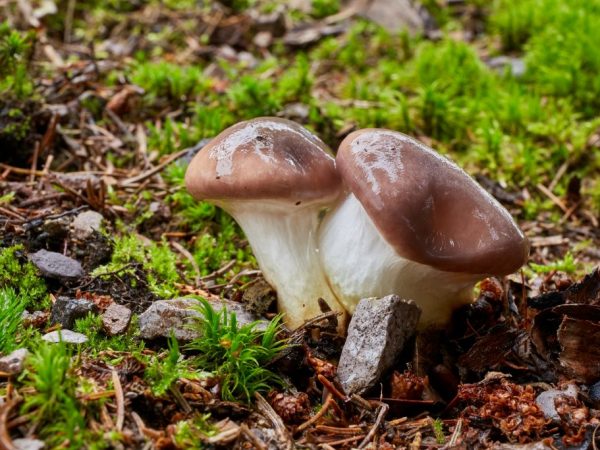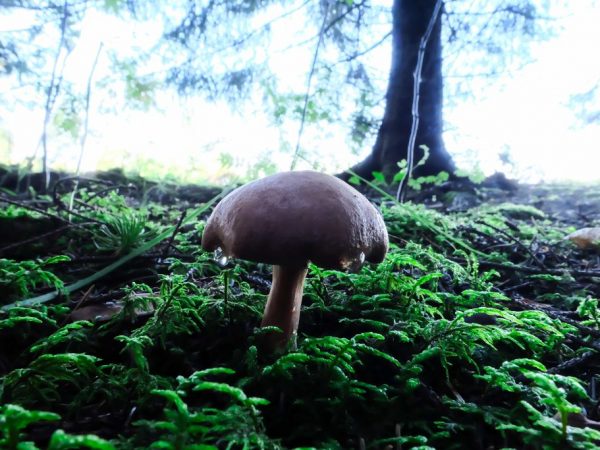Spruce Mushroom
Fir spruce is one of the mushrooms from the Gomfidia family, or Mokrukhovye. It also has other names - "sticky mokruha" and "slug". It got its generic name from the Greek word meaning "peg". The specific epithet translated from Latin means “sticky”.

Spruce Mushroom
Botanical characteristic
In mokruha, the spruce size of the mushroom cap ranges from 4 to 13 cm in diameter. It is fleshy in structure. The shape changes depending on the age of the fungus:
- in young mothers, the cap looks like a hemisphere with the edges wrapped in the direction of the mushroom leg and is connected at the edges with the leg by a frequent, mucus-covered blanket (or velum), which looks like a colorless film of filamentary fibers;
- later the cap takes the form of a convex cone, retaining the remains of the bedspread,
- an adult mushroom has a spread cap with a small tubercle in the central part or slightly depressed in the center.
The surface of the mushroom cap is smooth and covered with abundant mucus, when dry it becomes shiny. The color is gray, gray-brown or gray-blue, sometimes the edges are painted in a purple tint, and the middle is light. In an adult fungus, the cap surface is covered with black specks.
The season for collecting mokrushki starts from the end of summer and lasts all autumn, right up to the first October frosts.
The pulp is fleshy, fragile in structure. The color of the mushroom pulp is white, closer to the base of the leg is yellow, in some representatives with a pink tint. In older mushrooms, the flesh becomes gray. The taste is sweetish or slightly sour, but the classic smell is mushroom.
Fungal plates have the shape of a descending arc, strongly branched, 3-6 mm wide. Planted rarely, at intervals of 8-10 pcs. by 1 cm. The color of the plates is white or gray, over time it darkens to brown, keeping the edges white. In overripe wet mushrooms, the color of the mushroom plates turns brown with a purple tint, up to black.
Mass fruiting of the Gomfidia family occurs in the second half of August and lasts until the last days of September.
A massive mushroom leg will grow up to 5-11 cm in length, up to 1-2.5 cm in thickness. In young mothers, it is thick and swollen, in adults it becomes cylindrical, thickened at the base. The surface of the mushroom leg is smooth, slimy, covered with dark scales. The base color is lemon or bright yellow. In the upper part, at a distance of 1/3 of the cap on the mushroom leg, there is a weakly expressed mucous ring. In mature pugs, the leg above the ring is painted in a dark shade and darkens under mechanical action.
Irina Selyutina (Biologist):
Very often (almost always) in articles about mushrooms there are concepts - a private veil or a general veil, or both at once. In general, in mycology, the veil is called velum (this is a Latin word). So what is it?
Common bedspread (general velum): a formation (shell) that protects the developing fruit body entirely and when the fungus breaks it apart, its remnants form on the cap or flakes (like a fly agaric) or a kind of "bag-like" volves partially submerged in the soil and surrounding the bases of the mushroom legs.
Private bedspread (private velum): in contrast to the general, it covers only the lower part of the cap, protecting the hymenium with developing spores. When disputes mature, the private veil is torn, releasing them "to freedom." Remains of a private bedspread form a "skirt" or a ring on the leg, and can also hang from the edges of the cap in the form of patches or other formations.
By the way. For the name of a species of living organisms, including fungi, a compound name is used, which includes several words. The first word is a generic name, the second is a specific epithet. A species name may contain not two, but three words (two species epithets), the surname of the discoverer of the species may be present.
Similar varieties
Spruce mokruha does not have edible and inedible varieties similar in description. It shares a number of characteristics with the following edible members of its family:
- moss spotted: differs from it by the pulp reddening at the break and the color of the spore powder,
- purple moss: a mushroom cap of this type has a brighter color.
Representatives with dark caps have some similarities in the description with an autumn butterdish, which does not have mushroom plates.
Geography of distribution

The mushroom loves to grow in moss
Mokruha spruce prefers to settle in coniferous, more often spruce or mixed with spruce forests, chooses moss-covered forest litters, especially in places where heather grows. Grows more often in small groups.
Spruce bark is capable of forming a fungus root (mycorrhiza) with spruces, sometimes pines, which speaks of the selectivity of the species in this regard.
The mushroom is widespread in the northern and central regions of Russia.
Practical use
Edible spruce moss belongs to the 4th category of edibility. It should be eaten after heat treatment for at least 15 minutes. Suitable for cooking, pickling, pickling and canning. Suitable as an ingredient in sauces.
Before heat treatment, the mucous skin should be carefully removed from the cap of the mushroom and the mucus should be removed from the mushroom leg.
During heat treatment, the mushroom changes the color of the fruiting body to dark, which does not affect its quality gastronomic characteristics and nutritional properties.
Conclusion
The spruce mokruha mushroom belongs to the edible species of the Gomfidia family. It is found in the central and northern Russian regions. The collection period is August-October. It has no species similar in description among the poisonous and edible representatives. According to mushroom pickers, this mushroom is often confused by some with white, some with butter. In Europe, this species is classified as a good edible mushroom, and in Russia - to a very mediocre one.



